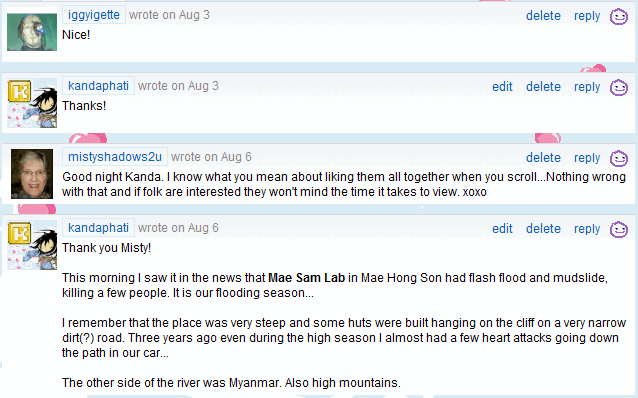My Old Blogs at Yahoo!360 / MTP
Family Trip to Mae Hong Son in April, 2008: Part III
Apr/30/2008
* Notes:
– Re-posted at Webs.com on August 2, 2011, displaying all the slideshows and videos.
– Unfortunately, a few years later slideshows at webshots were gone.
– Re-coded (with notes added) and posted at Neocities.org on Jul-10-2017.
Events, memories, pics & videos chronologically arranged.
Sunday April-13-2008 – We left Bangkok in the evening, stopped overnight in Nakorn Sawan.
Monday April-14-2008 – Left Nakorn Sawan for Tak, had lunch at a steakhouse near the town of Tak before heading for Mae Sariang via Tern and Lee.
Reached Doi Tao Lake and was sort of shocked to see NO WATER in the area that was supposed to be a huge lake. ("Doi" = mountain, "Tao" = turtle)
The huts in the picture below were actually rafts!
They were supposed to be floating in the lake.
What had happened? Global warming?!
The temperature at 4:30pm was at 38°C or 100°F. Very, very hot.
All the way along the road to Hod there was a creek a few meters beneath the street level with the water only knee-deep. Many people were there enjoying the splash. Sorry we did not take any pics here.
Ken on the way to Mae Sariang.
The road became steeper after we had passed Ob-luang National Park.
At 6 p.m. we saw a huge and crowded village with the name "Ban Bo Luang" on the hill to our left. To our right, we saw a colorful evening sky with the sun almost gone beyond the mountain tops.
What a view!
I was envious of those who lived here: they could see this beautiful sunset EVERYDAY!
We reached Mae Sariang when it was dark. Riverhouse Hotel was good.
See the pictures below.(These were taken on the next morning.)


At night there was a blackout and we saw fireflies outside our hotel room.
It had been quite a while for any of us grown-ups to see fireflies.
It might have been the first time for our boys to see such wonder in nature.
In the morning we found our room facing a river.
No wonder the hotel was named Riverhouse.
The other side of the river was full of huge trees. They looked great!
As for the blackout, we were told this happened often...
Tuesday April-15-2008 – There were the biggest teak trees somewhere in Salawin National Park but we did not go to the trees.
(The reason: A few years ago we followed the sign that led us to the biggest "kra-baak" tree in some national park in Tak. It turned out to be a very strenuous trip of more than 400 metres down the valley in a jungle ON FOOT along a slippery and narrow dirt stairway with a wooden but very shaky termite bitten handrail. The same way back up felt even worse. The whole trip took hours. After that we never follow any signs in national parks without making sure how far we had to walk.)
Salawin National Park
At the parking lot. The signs say "No Fishing" and "No Littering".
Enlarged below:

There was a small port by Salawin River about 47 km (30 miles) from the national park.
On the way to the port.

For your info, Salawin River is on the Thai-Myanmar border.
It is always exciting to see the neighboring country so near - and along the way!

The other side is Myanmar or Burma.
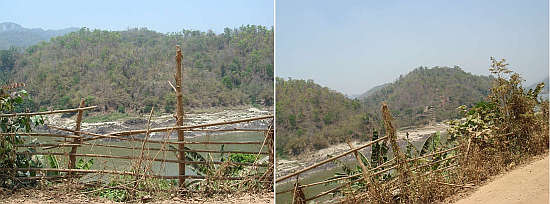
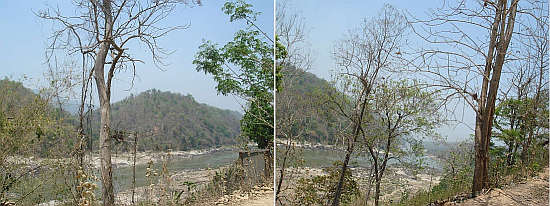
The road was high above Salawin River and VERY NARROW.
At first it was OK, but as the road left the villages up the mountains it got narrower and narrower and narrowwwerrr...
We managed to reach Mae Sam Lab village gate safely.

I did not drive, but was totally exhausted....

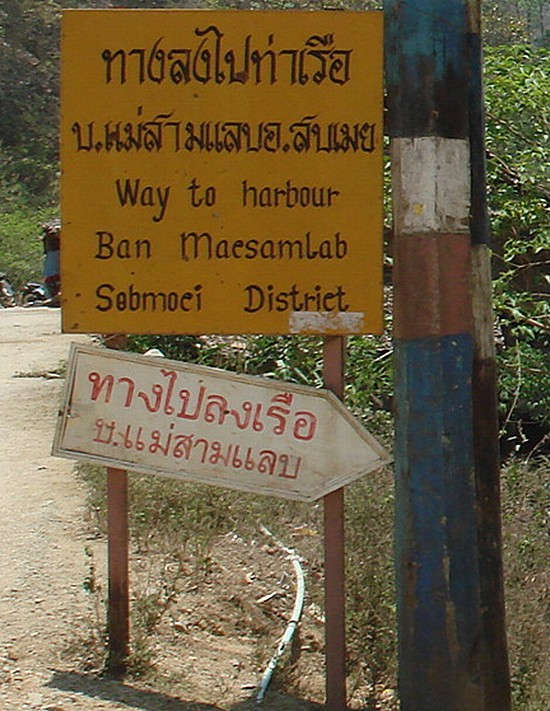
There were some huts in front of the gate .

The village was a few turns beyond the gate down the very steep road.
Mae Sam Lab port was of course towards the end of the road and could not be seen from the gate.
I had almost wanted to give up when I saw that steep slope!


We went down the narrow path anyway, and I felt like having several heart attacks.
The locals down there looked more Burmese than Thai. Some people had streaks of white or yellowish powder on their faces. Burmese sunblock?
At Songkran they were having fun splashing water at anyone passing through. Including cars.
The huts and wooden houses at the street level down here were actually hanging ON THE CLIFF!
The valley looked deep. I saw a huge sign: "Children without nationality should register (on a certain date) in order to apply for Thai citizenship". Too bad I did not have enough time to take any pictures.
The port was disappointingly small. We had expected to see something "grand" after all those twists and turns along the way down here. Oh, well, never mind...

The way back up was faster than what I had thought. After we got out of that village we passed by a small immigration office on the main road. (Pics on the right and below.)
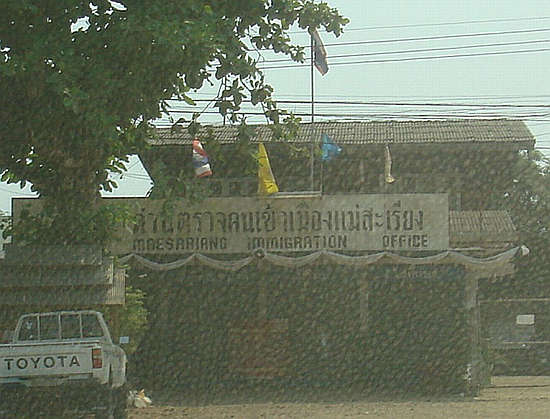
On the way to Mae La Noi.
In Mae La Noi there was an open space by the road with a building dedicated to the King, and a few huge outdoor tribal swings.
It was very hot in the afternoon at 3 p.m. and the place, though beautiful, looked deserted.

The sign in the bottom right photo above says: King's 80th Birthday Park.
Enlarged below. Many parks nation-wide have this same name.

The sign says: "Tribal Swings, Land of Pearl, Western Lanna, Mae La Noi"
These swings were huge!
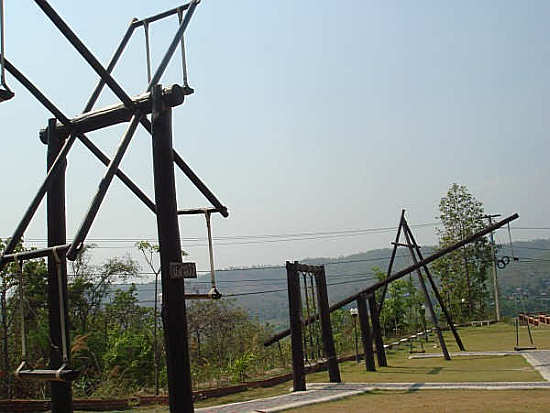
From there we went to Calcite Cave.
Its name in Thai, "Tham nam keng", means an ice cave.
"Tham"=cave, "nam"=water, "keng"=hard, solid.
The big sign that greeted us looked amusing:
"Welcome Thousand-Curve Conquerors to the Ice-Cave".
("Thousand-Curve Conquerors" means anyone that has managed to pass through more than a thousand curves to reach Mae Hong Son.)
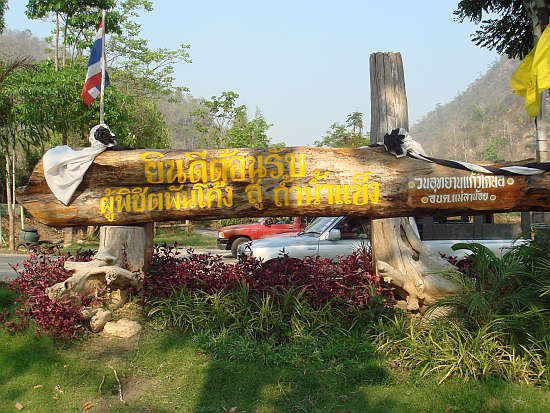
Its formal Thai name given by our Queen on Feb-19-2001 is:
"Tham Kaew Komol" (Cave of Beautiful Crystals).
"Kaew"=glass or crystal, "komol"=beautiful.
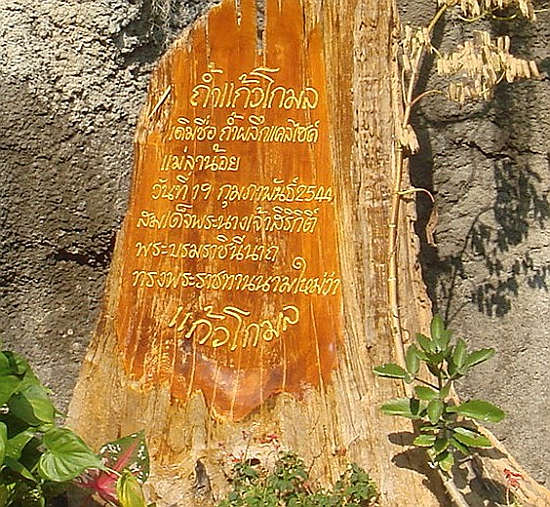
We reached its parking lot and was told to leave our car there and go further up by their shuttle bus. The road up was narrow, so was the entrance to the cave. Only a small group of people were allowed to enter the cave at a time.
The temperature inside was very high, about 40°C, with terrible humidity. We were told not to bring our cellphones, cameras, or bags with us.
Although there was a locker for us I did not want to risk myself so I decided not to deposit my handbag and go in but to wait outside. It must be awful when even small handbags were not allowed in there!
When my boys returned they said it was beautiful inside but indeed HOT and the way down the cave was extremely narrow. The small "chambers" in there all had elegant Thai names.

The reception area displayed info of the cave, and a picture of the person who discovered it in November 1991. His name was Sanan Boontongmai.
Left and below: Cave entrance.
The Thai writing at the cave entrance can be roughly translated as:
"The attractiveness we see here will fade away very soon but if we perceive with our heart we shall always remember the Beautiful Crystal Cave."
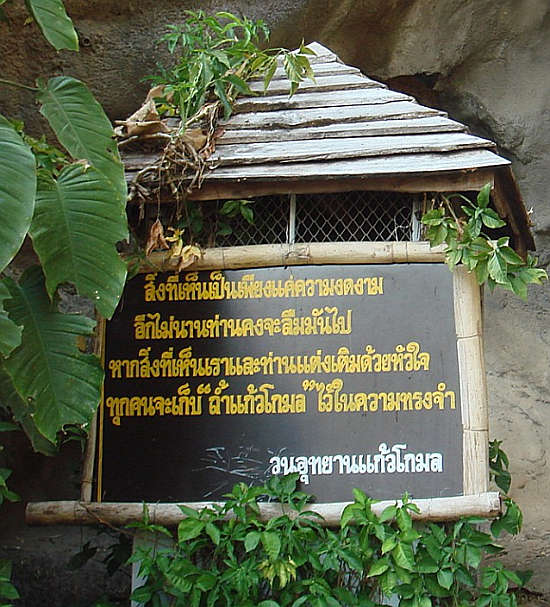
One of my friends emailed me pps of Naica Crystal Cave in Mexico. The crystals in there looked GIGANTIC. The temperature inside that cave was 50°C! Calcite Cave in Mae La Noi was so tiny if compared.
Click to see pics of Naica Crystal Cave brought to you by Google.
I took a screenshot of this search result:

We headed north after this. Kun Yuam was about 67 kms away. The road looked wide and smooth. I was relieved.
There was a WWII museum in Kun Yuam. We visited it there in 2004 but not this time (therefore NO pics here). Below are the old photos taken in Dec 2004.

Top right:
Tony in one of the rooms in the Museum.
The writing below the flags says:
RIP, Our Comrades.
There were lots of signatures on the Japanese flag.
Wars are never good, but one does not have to be a Japanese to feel so heart-wrenching upon visiting this museum.
See bigger pics:
Kun Yuam
(Dec 31, 2004)
There were a few very rusted tanks, jeeps, guns, all kinds of weapons, soldiers' clothes, kettles, water bottles, spoons, hats, boots, lamps, suitcases, etc.
The caretaker of the museum said after the war the Japanese soldiers, in order to avoid being arrested, spread out and hid in the villages with the help of the locals.
When the soliders could safely depart for their home country they left all their belongings behind to the villagers, who were mostly the Shan people, or "Tai-yai" (=the big Thai; "yai"=big; cf: the Thais in the Central part of Thailand are called "Tai-noi"; "noi" means small).
Later the villagers collected all the things and set up this the museum.
The departure, according to the records, was full of sorrowful feelings on both sides.
Unlike the Chinese and the Koreans, almost all the people in Thailand had no bitter feelings towards the Japanese soldiers.
Way after the war, some Japanese veterans managed to return to Kun Yuam almost every year to visit their old "friends".
A few of them even set up a scholarship for local children in there.
At dusk we reached Rooks Hotel in the city of Mae Hong Son.
Doi Kong Mu is a hill near downtown Mae Hong Son. There is a temple on top of the hill. It is called Wat Pra-taat Doi Kong Mu.
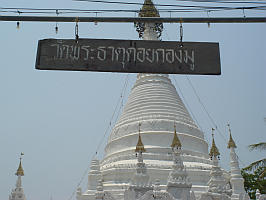
From top of Doi Kong Mu we could see the airport and the city center of Mae Hong Son.

Airport runway viewed from Doi Kong Mu:

Mae Hong Son is well-known for its fogginess:
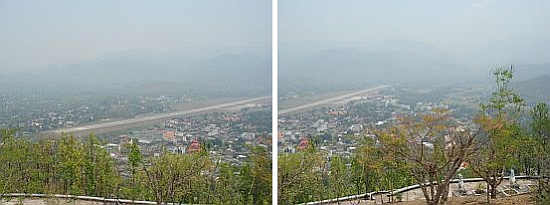
Mae Hong Son city center:
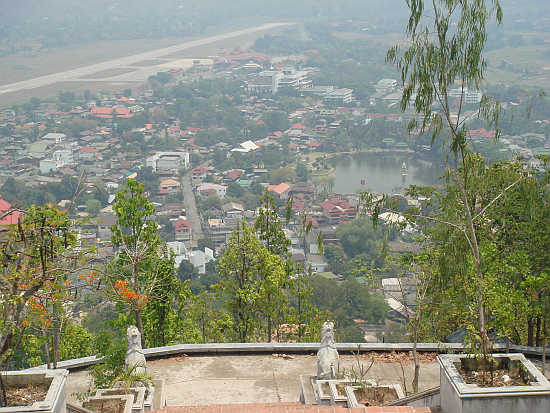

This is what Ken looked like in April 2008:

Pictures of the temple, its parking lot and a few souvenir shops on top of this hill:
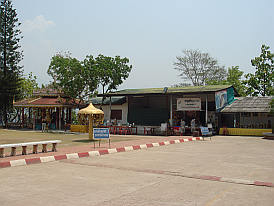

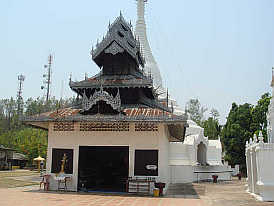

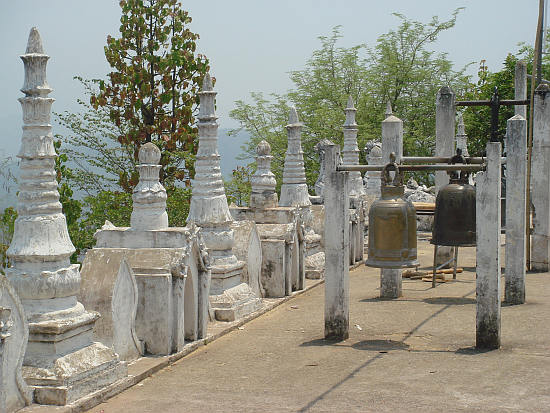

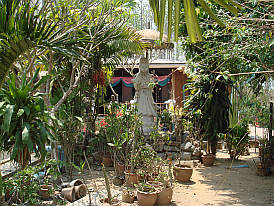
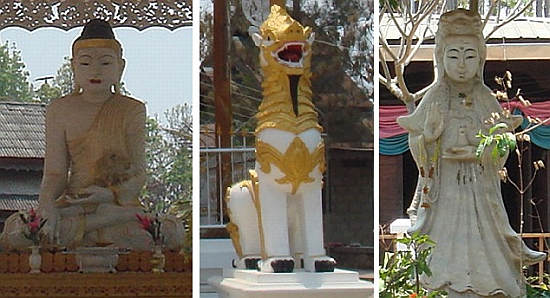
Coming down Doi Kong Mu:
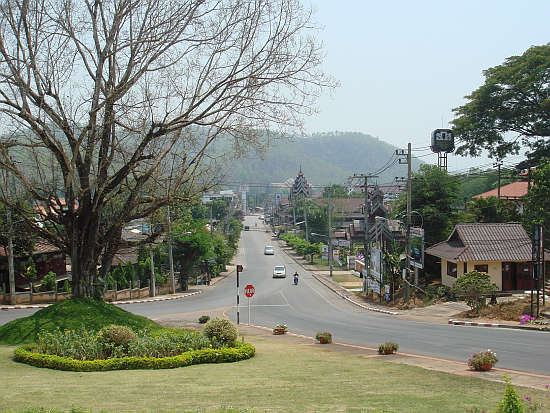
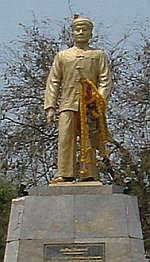
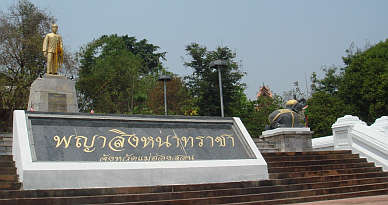 There was a monument at the foot of the hill to commemorate the first ruler of Mae Hong Son, who was of Shan tribe.
There was a monument at the foot of the hill to commemorate the first ruler of Mae Hong Son, who was of Shan tribe.The elephants surrounding the Shan King:

Anyone arriving in Mae Hong Son could visit its city office, which was located near Doi Kong Mu and the Monument, and pay 20 Baht (about a little more than half a US Dollar) for a certificate of having successfully passed through the 1864 curves to Mae Hong Son. There was also a sticker for the car. It was the second time we got them. The first was in 2004.
Ken receiving the Certificate and a Sticker:
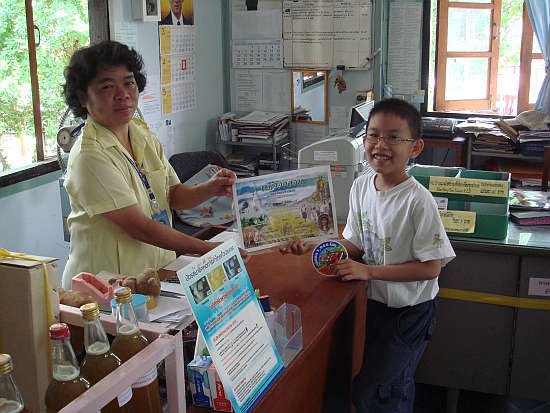
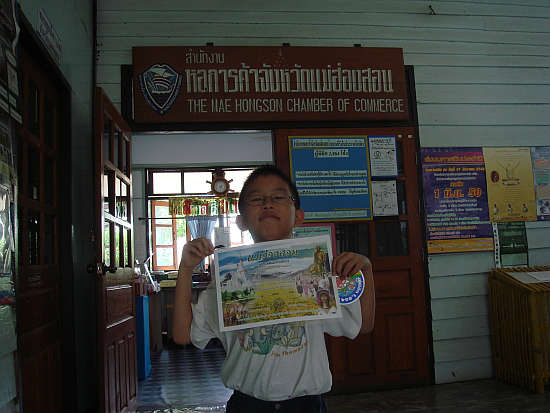
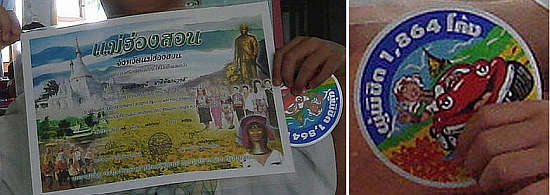
Next: "Tham Pla" (Fish Cave) ("Tham"=cave, "pla"=fish)
 We had sticky rice, papaya salad, grilled chicken, grilled sliced pork, and boiled eggs at a restaurant in front of Tham Pla National Park.
We had sticky rice, papaya salad, grilled chicken, grilled sliced pork, and boiled eggs at a restaurant in front of Tham Pla National Park.It was good but there were flies. We had to keep waving our hands over the food while eating. The restaurant owner said we "rum"( =danced Thai style) while eating.
What a good expression, hahaha!

The cliff across the street that overlooked the parking lot reminded my boys of the movie Transformer. (Enlarged pic on the right below.)
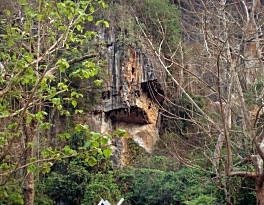
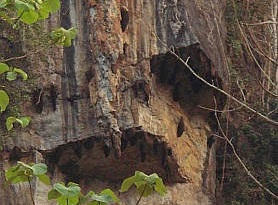
Before entering the cave:
 Bottom left of the above: To my left there was a creek. There was one more creek to my right but not shown in this photo. Both came from the cave.
Bottom left of the above: To my left there was a creek. There was one more creek to my right but not shown in this photo. Both came from the cave. Bottom right of the above: Cave entrance. Do you notice the big orb?!
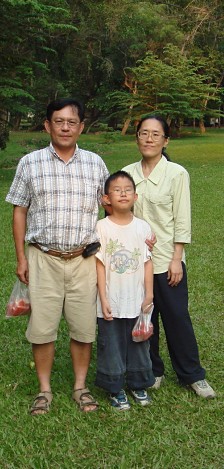
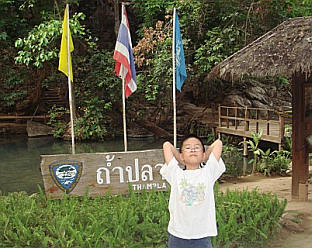
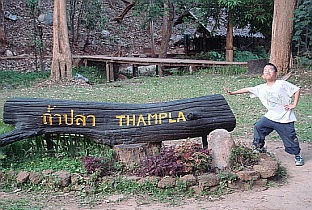 BELOW: Statues and signs at the cave entrance.
BELOW: Statues and signs at the cave entrance. Sign on the left: "Do not enter into this area".
Sign on the right: "Area to place the candles and incense sticks."
Have you noticed the orbs in the photo?

 Left: The fish in the cave.
Left: The fish in the cave.I remember on our first visit to this place in Dec 2004 we fed tangerine to the fish in the cave. This time we fed them watermelon. Sliced watermelon was 20 Baht/bag. I do not remember how much the tangerine was. Didn't see any this time. The fish in there seemed to love fruits.
Below: Ken with a bag of watermelon before & after entering the cave: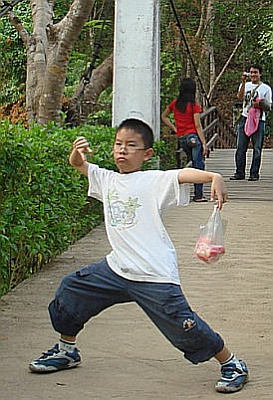
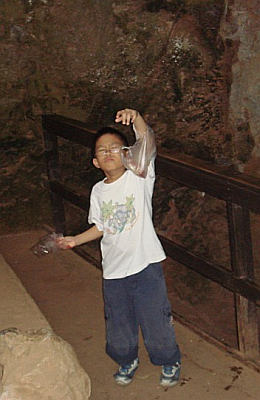
A few videos recorded at Fish Cave:
Interviewing Ken:
Is the bridge high? Yes.
How high? I don't know. About 100 - 200 meters.
Are you afraid? Yes.
Do you see any fish? No.
Why? Because there is no fish! Hahaha!
(Note: In fact, the bridge was just a few feet above the water,
and there were lots of fish in the water!)
On another smaller bridge:
Ken probably had never seen or touched a water mill.
Feeding watermelon to the fish in the cave:
The cave looked small but the fish in there were big. They moved fast, too.
Thursday April-17-2008
Good morning Mae Hong Son!
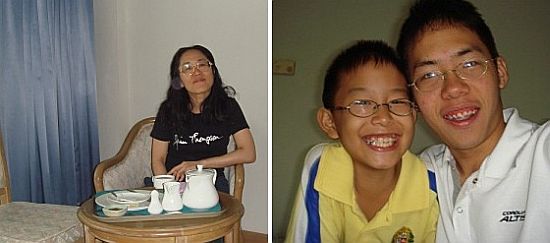
Elephant ride


I did not ride. Elephants are too tall for me and I always feel insecure while riding. I might feel better with some seat belt but there is never one. Ken brought with him a comic book to read while on the elephant's back. The ride into and out of the jungle was an hour.
Experience the 1-hour ride with a ten-year-old:
(Summarized into a little more than 2 minutes here, in 5 videos.)
1. On an elephant 1 (1.01 minute)
2. On an elephant 2 (15 seconds)
3. On an elephant 3 (25 seconds)
4. On an elephant 4 (17 seconds)
5. On an elephant 5 (21 seconds)
After that, we left the town of Mae Hong Son, went passed Fish Cave, arrived at Phasua Waterfall, took some pics, and went up to Pang Tong, where there were a palace and many Royal Projects. The road was very steep and very beautiful up there.
Phasua Waterfall. Not much water during dry season:


On Pang Tong, we saw a herd of furry sheep. Those must have been one of the Royal Projects. I wonder if sheep feel hot in summer under the tropical sun?

We saw a (Thai) school, too, but did not take any pictures there.
Nearby, there was a Naresuan Memorial to commemorate the most important King (AD 1555-1605) "of the Ayutthaya Kingdom from 1590 and overlord of Lan Na from 1602". (Wikipedia).
Before climbing the steps up to the Memorial:


Looking down from the Memorial:

On the way to Pai we passed through Pang Mapha. The road was more than 860 meters above sea level and was full of steep bending curves. The mountains across the valley looked lower than the road.
Sompote on Pang Mapha:

I looked terribly tired at the 1548th curve, 869 meters above the sea:
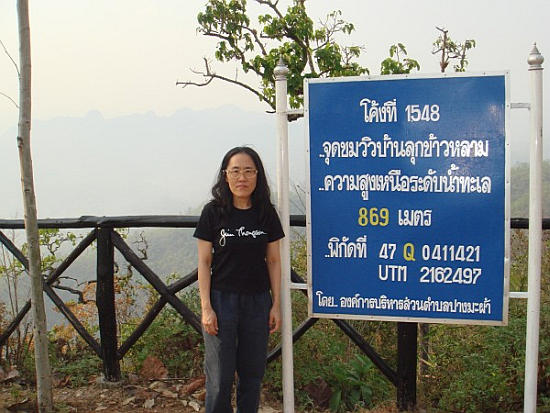
The sign says "Welcome to Pang Mapha Sea of Fog Viewpoint".

Left below: The signs point to a few caves and the town of Pang Mapha.
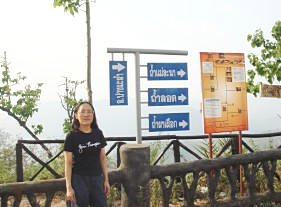
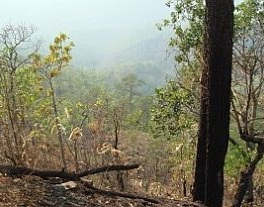
It was quite a relief when we reached Pai. The town was on a rather flat area.
What a surprise, Pai was a lot bigger than a village! We stayed in Belle Villa Resort for one night. Below: Pic of Tony and Ken in the lovely hotel garden.
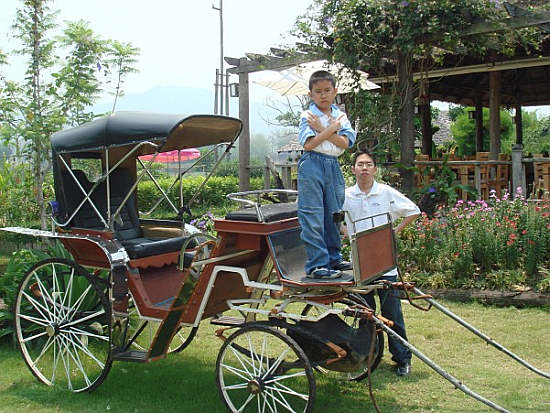
The place was good but guess what? There was a blackout again!
During the blackout it was DARRRRRK in our rooms. All the street lights were out, too, but we saw lights at the information desk. We went there asking for extra flashlights.
The hotel receptionist told us the power in the guests' rooms was from Mae Hong Son and there must have been rain or storm somewhere between the city of Mae Hong Son and Pai, whereas the power in the information hall was from Mae Taeng in the province of Chiang mai, and obviously there was no rain in Mae Taeng.
The two sections were only a few meters apart and were within the same fence!
We heard that power out in this town was frequent. It happened almost every evening and each time it lasted for an hour.
The town of Pai was full of tourists from abroad. Many shops looked very "foreign". The customers in the shops were mostly foreigners, too. We felt as if we were not in Thailand.
There was a supermarket that had lots of exotic (in my eyes) imported goods including potato chips from Germany and orange juice from Australia.
If it weren't for a few red ants crawling at the cashier counter that reminded me I was in some remote place far, far away from the central plain of Thailand I would have thought I was in some supermarket on Sukhumvit Road in the city center of Bangkok.
We bought newspapers from a shop next to the supermarket. The shop had several newspapers including Wall Street Journal! We do not have that in any shop around our townhouse complex in Bangna, Bangkok!
The shop owner told us the Thai tourists prefer to come to Pai in winter (Dec ~ Feb) whilst the overseas tourists would visit in summer (April).
He said when the Thais came the foreigners would go away. I asked why. He answered: "Because the foreigners do not want to be 'disturbed', and the Thais are usually noisy." What the….?!
Friday April-18-2008
Our next stop was another Chinese (ex-)refugees' village, San ti Chon, which means a place for peace-loving people. In the Chinese characters, however, the same pronunciation simply means a village in the mountain.
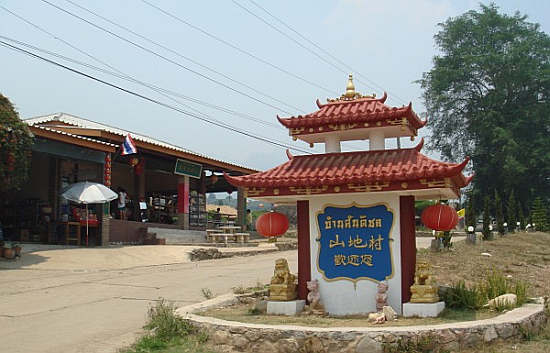
It was around noon with scorching heat, and I was getting impatient when asked to pose for pics. Again, you can see how terrible I looked:
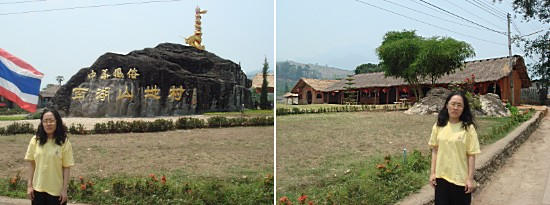
We left the village and came to Pai WWII Memorial Bridge.

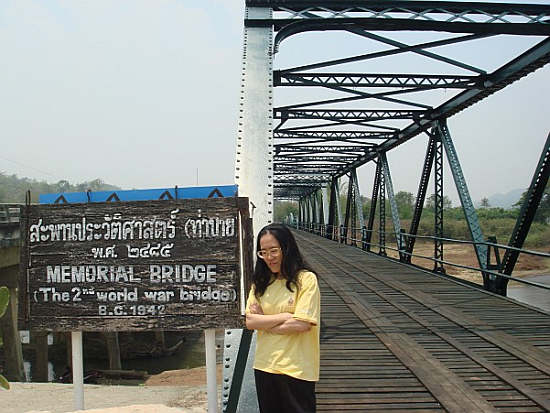
It was so hot I didn't immediately notice anything wrong with its sign:

Built in B.C. 1942 ?!
Pai Hot Spring National Park or "Pong Nam Ron Tha Pai" was just a few kilometers away from the main road.

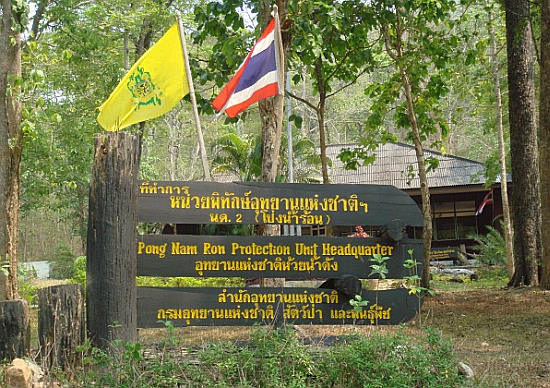
One can play Tarzan here....
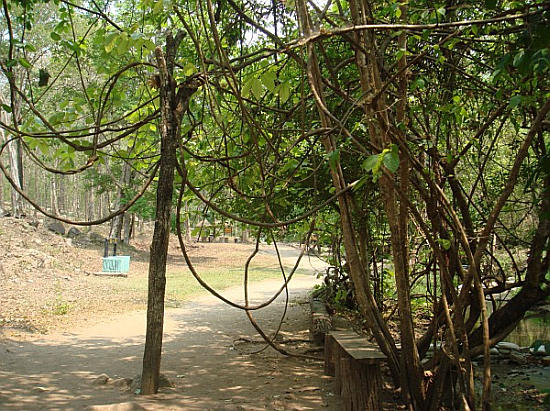

Its hot spring was 80°C.

Of course we had to buy some eggs to boil.
It has always bee a practice to boil eggs at hot springs, haha!

What?! Hahahaha! (Actually this was another spot.)


However, the most impressive in there for my sons and me was not the hot spring or the scenery, but the groups of 10 or more spiders in the corners inside the restrooms, each with its body only about the size of a coffee bean, but each leg was like 3 inches long. They clustered together in the lower corners of the walls. We had never seen that kind of spiders, not even in the movies.
As soon as I reached the restroom, even before I could close the door, they suddenly started to spread out and move together at the same speed as if fleeing from some approaching menace. It was amazing to see half a wall of spiders moving up. My sons saw the same thing in men's room. I didn't scream but I surely didn't dare to use the restroom there.
No pics of the spiders though.
We reached Chiang Mai before dark. There was a severe traffic jam on the road long before entering the city of Chiang Mai. Sigh.... Civilization!
I was glad we chose to stay in Novotel Chiang Mai. It was good: no blackouts, and the rooms were clean. We ate at Fuji restaurant in a shopping center near Night Bazaar. It had been a long time since we last enjoyed our meal in an air-conditioned place. I felt it sooooooooo gooooood to eat without having to worry about any flies around my plate!
Welcome back to "Civilization"! Ha!
Saturday April-19-2008
We left Chiang Mai and stopped at a national park in Tak that displayed petrified wood or wood that turned into stone.
Those fossilized trees of 800,000 years ago had been discovered only a few years ago and they were humongous.
The signs:
"The longest (tallest?) petrified tree in the world; Only 50 meters away."
And, "No vehicles allowed." We had to walk there.
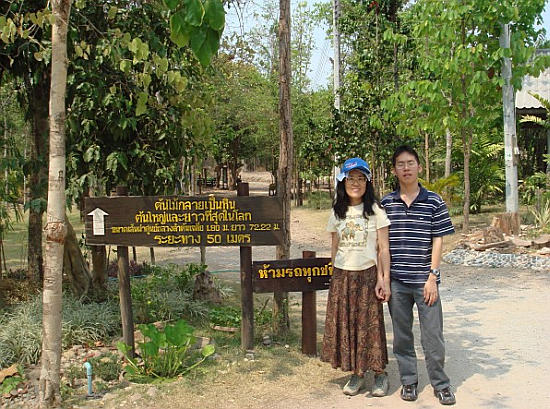
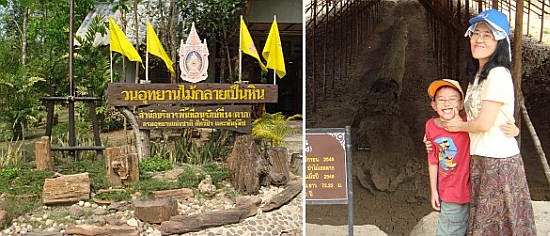
The pic below showed the best preserved Petrified Wood.
The small sign in the middle says "Length: 72.22 meter". That is almost 237 ft.
Offerings can be seen near the sign.
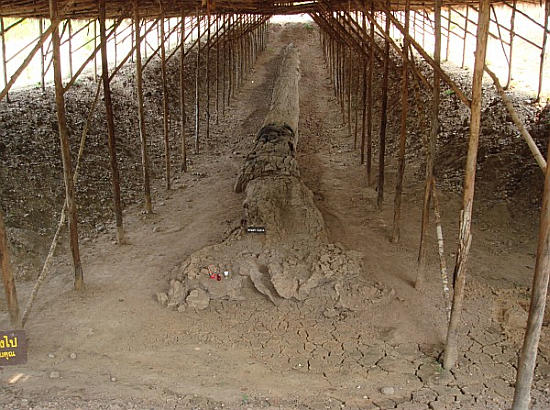
The big sign in front of the 72.22-meter petrified wood says:
Discovered in November 2003 (Buddist year 2546) by the Tak Forestry Bureau Team Leader Mr. Wachira Muangkaew. Average diameter: 1.80 meters (= 6ft). Length: 72.22 meters. Age: about 800.000 years old
The smaller sign on the left says "Do not go down. Thank you."
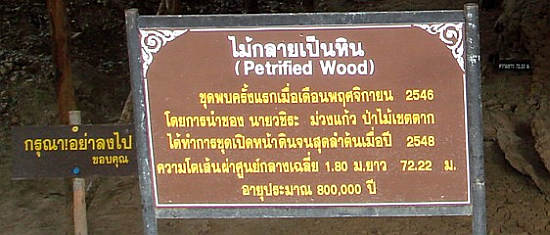
Other less well-preserved petrified wood:
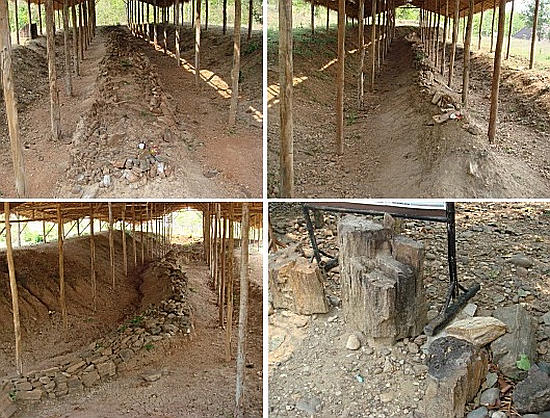
These looked like wood but felt like rocks. Very hard.
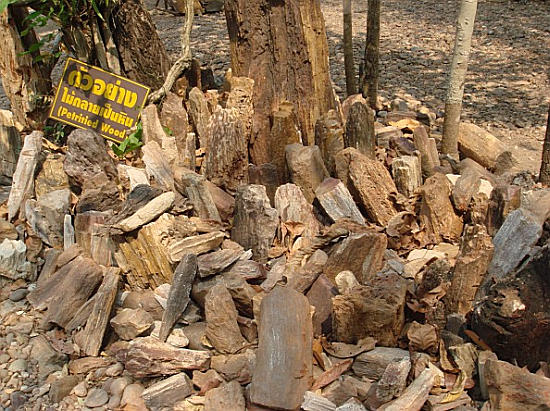
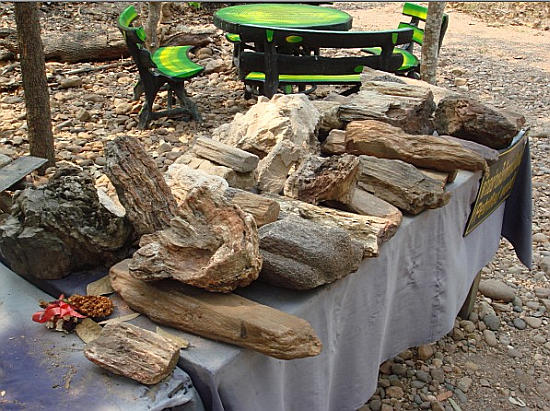
Inside a piece of petrified wood:
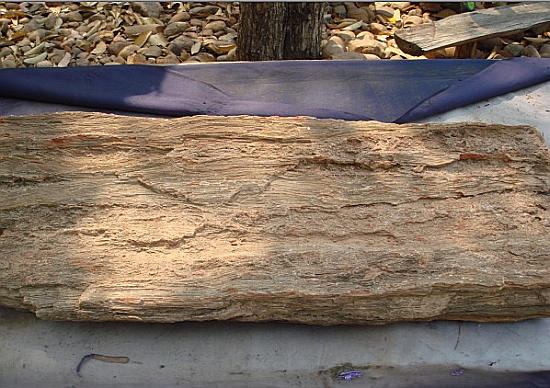
Filling up the gas at Esso before leaving Tak.
We usually do not see wide-open space with greens and mountains in Bangkok!

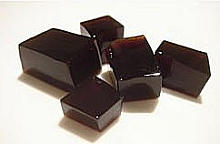 The best Grass Jelly
The best Grass JellyOn the way we passed by Kamphaeng-pet.
The most important for Tony and Ken on this trip was, in fact, to buy Cha-kang-rao's grass jelly in Kampaeng-pet.
Right: grass jelly pic. (Source: Wikipedia)
Our boys had missed it (terribly) ever since they had this brand of grass jelly many years ago when visiting Bueng Chawak Aquarium in the province of Supanburi.
(I will have to post pics of our visit to Bueng Chawak in March 2008 someday!)
"Cha-kang-rao's s is stickier and yummier than other brands," said my boys.
Later someone told me Cha-kang-rao's grass jelly was very famous and it had been on TV at least once.
Yet it was not available in most of the shops or supermarkets in Bangkok.
The town of Cha-kang-rao is in Kampaeng-pet province. Kampaeng-pet means diamond wall. We did see big artificial "walls" with welcome signs upon entering the province.
To this day I still do not know what Cha-kang-rao means, and I always feel it difficult to pronounce the word correctly.
Anyway, the boys were so glad when we found their beloved brand of grass jelly at a store inside PTT gas station.
The salesperson in there gave us a detailed introduction of what grass jelly was, how it was produced, including how superior the brand was to others'.
Outside the store next to a small fountain there was a pot of the grass with beautiful pink flowers and green leaves. My first time to see them. I had seen only the dried one.
According to the old website of Cha-kang-rao's grass jelly factory (*the site "chaoguaychakangraw.com" does not exist now), we do NOT grow such grass in Thailand. The raw materials are imported from China, Indonesia, and Vietnam.
We got back home at around 10 pm that evening. It was a long drive. We had travelled about 2000 Kms (1250 miles) in that week. All the time only Sompote did the driving, but he enjoyed it tremendously. The boys were extremely happy to be back home and the first thing they did was to rush to their computers.
– The End –
Screenshot of the comments at MTP (journal/item/170)
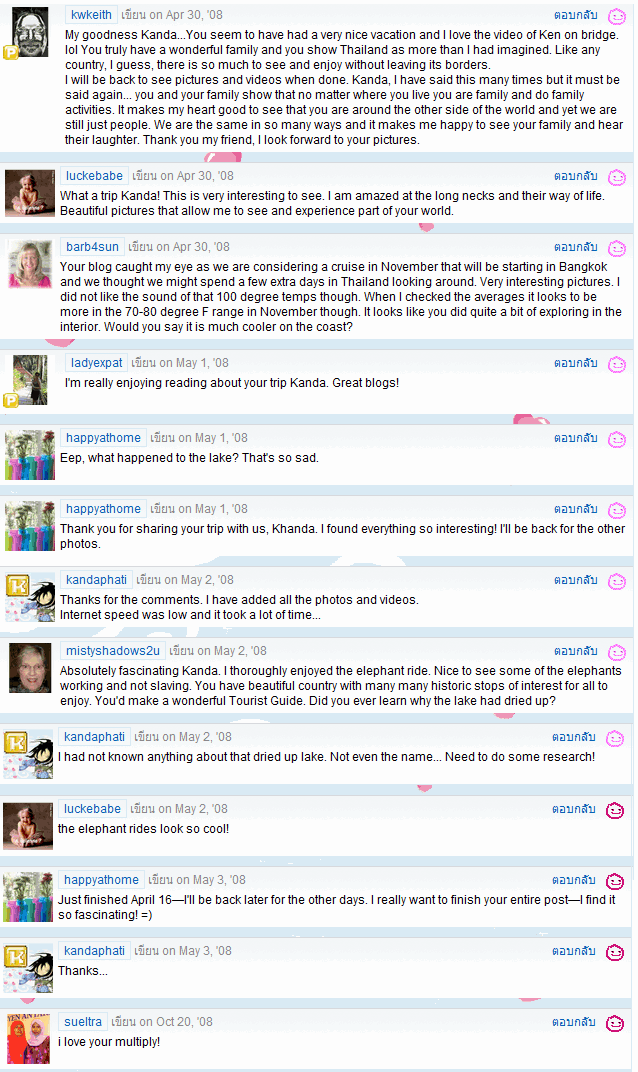
More comments at MTP (August 2011)
